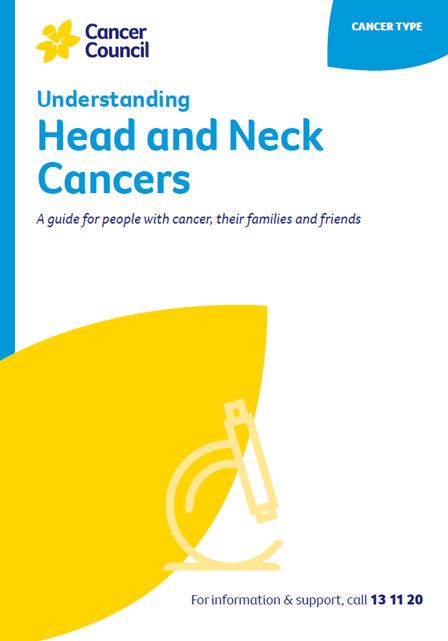- Home
- Head and neck cancers
- Diagnosis
- Tests
- Imaging tests
Imaging tests for head and neck cancers
You will usually have at least one of the imaging tests described below, often before a biopsy is done. These tests give more details about where the cancer is and whether it has spread to other parts of your body.
Learn more about:
Ultrasound
An ultrasound is sometimes used, particularly to look at the thyroid, salivary glands and lymph glands in the neck.
For this scan, you will lie down and a small device called a transducer is coated with gel and moved over the area. The transducer sends out soundwaves that echo when they meet something dense, like an organ or tumour. A computer creates a picture from these echoes. An ultrasound is painless and takes about 15–20 minutes.
Learn more about ultrasounds.
CT scan
A CT (computerised tomography) scan uses x-ray beams to create detailed cross-sectional pictures of the inside of your body.
Before the scan, you may have an injection of dye (called contrast) into a vein to make the pictures clearer. The dye may make you feel hot all over and leave a strange taste in your mouth for a few minutes. For the scan, you will need to lie still on a table that moves in and out of the CT scanner, which is large and round like a doughnut. The scan itself takes about 10 minutes.
Learn more about CT scans.
Before having scans, tell the doctor if you have any allergies or have had a reaction to dyes during previous scans. You should also let them know if you have diabetes or kidney disease or are pregnant or breastfeeding.
PET-CT scan
A positron emission tomography (PET) scan combined with a CT scan is a specialised imaging test. The CT helps pinpoint the location of any abnormalities revealed by the PET scan.
You may need to fast or follow a special diet the day before this scan, so that you get the most accurate results. Before the scan, you will be injected with a glucose solution that contains some radioactive material. Cancer cells show up brighter on the scan because they take up more glucose solution than the normal cells do.
Next, you will lie down or sit quietly for about an hour as the glucose spreads through your body. Then you have the PET scan, which will usually take about 30 minutes. The CT scan may be done before the PET scan or at the same time.
Learn more about PET-CT scans.
MRI scan
An MRI (magnetic resonance imaging) scan uses a powerful magnet and radio waves to create detailed cross-sectional pictures of the inside of your body. Before the scan, a dye may be injected into a vein to help make the pictures clearer. During the scan, you will lie on a table that slides into a large metal tube that is open at both ends.
The noisy, narrow machine makes some people feel anxious or claustrophobic. If you think you may become distressed, mention this beforehand to your doctor or nurse. You may be given medicine to help you relax, and you will usually be offered headphones or earplugs.
MRI scans usually take 30–90 minutes.
Learn more about MRI scans.
X-rays
Many people will also have a special x-ray called an orthopantomogram (OPG) to check the jaw and teeth.
→ READ MORE: Staging and prognosis for head and neck cancers
Podcast: Tests and Cancer
Listen to more of our podcast for people affected by cancer
A/Prof Martin Batstone, Oral and Maxillofacial Surgeon and Director of the Maxillofacial Unit, Royal Brisbane and Women’s Hospital, QLD; Polly Baldwin, 13 11 20 Consultant, Cancer Council SA; Martin Boyle, Consumer; Dr Teresa Brown, Assistant Director Dietetics, Royal Brisbane and Women’s Hospital, Honorary Associate Professor, University of Queensland, QLD; Dr Hayley Dixon, Head, Clinical Support Dentistry Department, WSLHD Oral Health Services, Public Health Dentistry Specialist, NSW; Head and Neck Cancer Care Nursing Team, Royal Melbourne Hospital, VIC; Rhys Hughes, Senior Speech Pathologist, Peter MacCallum Cancer Centre, VIC; Dr Annette Lim, Medical Oncologist and Clinician Researcher – Head and Neck and Non-melanoma Skin Cancer, Peter MacCallum Cancer Centre, VIC; Dr Sweet Ping Ng, Radiation Oncologist, Austin Health, VIC; Deb Pickersgill, Senior Clinical Exercise Physiologist, Queensland Sports Medicine Centre, QLD; John Spurr, Consumer; Kate Woodhead, Physiotherapist, St Vincent’s Health, Melbourne, VIC; A/Prof Sue-Ching Yeoh, Oral Medicine Specialist, University of Sydney, Sydney Oral Medicine, Royal Prince Alfred Hospital, Chris O’Brien Lifehouse, NSW.
View the Cancer Council NSW editorial policy.
View all publications or call 13 11 20 for free printed copies.
